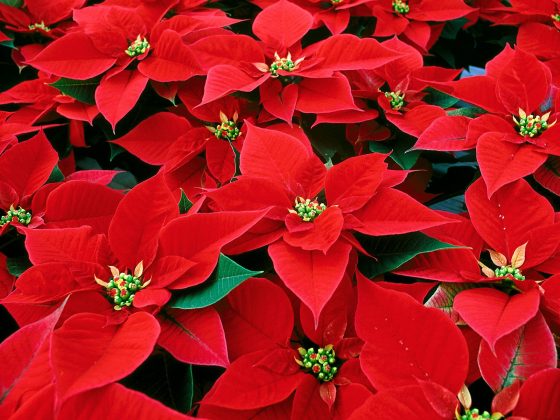Flowering and foliage plants which grow and bloom in the winter can make welcome gifts, however, taking proper care of them determines how long they remain attractive and enjoyable.
Proper watering is critical. A large plant in a small container will dry out fast. Indoor humidity is low during the winter season. Check your plants daily and do not over water, over watering is just as unhealthy for a plant as under watering. When the plant’s soil is dry to the touch, water until some drains from the bottom of the pot, discard drained water. Misting holiday plants is not recommended as this could create an environment for foliar disease. Improper watering can result in root or crown rot in some plants so make sure they need water before watering.
All plants must have proper lighting to extend their life through the indoor holiday season. Placing your plants where they will receive high levels of indirect light or under a lamp. Low light levels will shorten their life and your enjoyment of these seasonal beauties.
Cooler temperatures (60-65°F) lengthen the life of flowering plants, while extremely high temperatures (75-80°F) will usually shorten their display life. This is particularly true of forced bulbs, which decline rapidly in the heat. Some foliage plants are subject to chilling injury below 55°F. Avoid abrupt temperature changes by placing plants away from doors, vents, and drafts.
Not all, but many holiday plants even under ideal conditions last only a few weeks, and do not need fertilizers. Plants that can be kept indoors for many months will benefit from a light application of a water soluble or a slow release fertilizer. Plants kept for a long time eventually outgrow their containers and might need to be repotted. Prepared soil mixes are readily available. Choose a container, preferably one with good drainage holes, proportional in size to the plant.
African violets
African violets are excellent indoor flowering plants. Available in many flower colors, they produce flowers year-round under the proper growing conditions. Individual flower clusters may last three to six weeks under good conditions. East and west facing windows are some of the best locations for violets to promote continuous blooming.
Amaryllis
Amaryllis come in a variety of colors, orange, red, white, and pink, and bloom four to six weeks after the bulbs are planted. Individual blooms may last three to four days with a single flower stalk usually producing three or four large, trumpet-shaped blooms; larger bulbs may produce more than one flower stalk. Place these plants outdoors in bright light (not direct) once temperatures are warm enough allowing the foliage to grow and develop. Throughout the summer months water and fertilize until fall, watering less often, cutting back the leaves. When the leaves have died completely let the soil dry and place the bulb in a cool, dry place for four to eight weeks before resuming watering.
Holiday Cactus
Holiday cactus are three related plant species that look like Christmas cacti. The three types bloom at different times of the year and can be found in flower at Thanksgiving, Christmas and Easter. All three types require bright sunlight and moderate moisture levels. South facing windows are excellent places for a holiday cactus. After the six weeks of holiday blooming, remove spent flowers and apply a houseplant fertilizer. Plants can be grown outdoors in semi-shady places and stem pieces of three segments or more are easily propagated. Holiday cacti should bloom about the same time every year.
Cyclamen
Cyclamen are excellent holiday plants that are usually available from October through March. White, pink, lavender, purple, red, and bicolor varieties are usually available. The plant produces many flowers, remaining in flower two to four months with proper care. Cool indoor temperatures (50-60°F) will make the flowers last longer. Like other holiday plants cyclamen are easily damaged from improper watering.
Gloxinias
Gloxinias are very similar to African violets and may be available year-round. Individual blooms will last four to six days and gloxinias will usually flower over a two to four week period. Bright, indirect light is necessary to keep the plant in flower. Unlike African violets, they need to rest before re-flowering.
Kalanchoes
Kalanchoes are available year-round in many colors. Flowers will last three to six weeks in mild temperatures (65-80°F) with medium light and if the plants are kept properly watered.
Poinsettias
Poinsettias were introduced to the US from Mexico by Joel Roberts Poinsett, a botanist, physician, and the first US Ambassador to Mexico. Poinsettias are part of the Euphorbiaceae or spurge family. The showy colored parts of the poinsettias are not flowers, but are colorful bracts of poinsettias which may stay bright for months if you care for them properly. Bright, indirect light and frequent watering are essential. Do not allow the plants to wilt, but watering too often can damage roots.
What are your experiences with growing flowers and plants in the winter months? Share them by sending in your comments, questions, stories, photos or videos.










